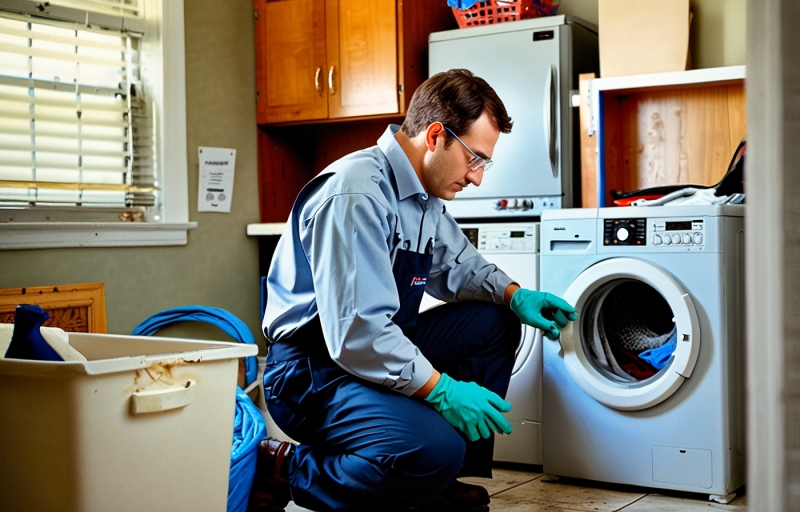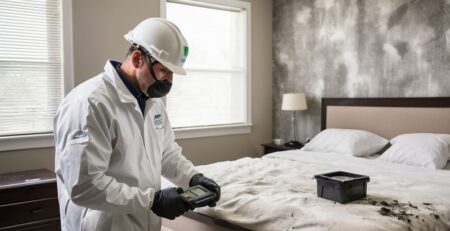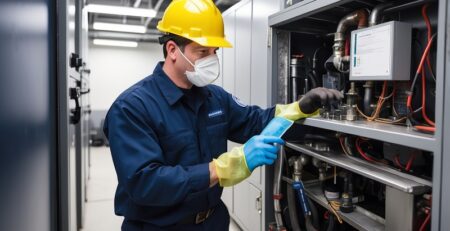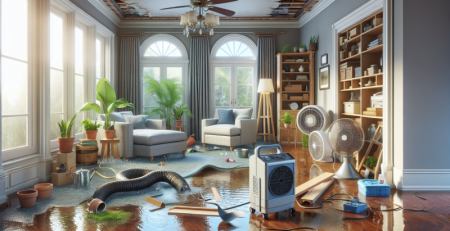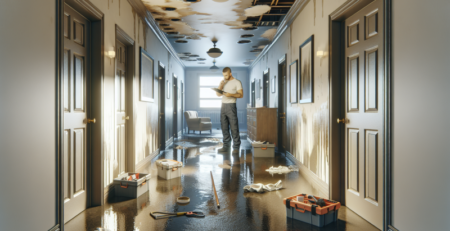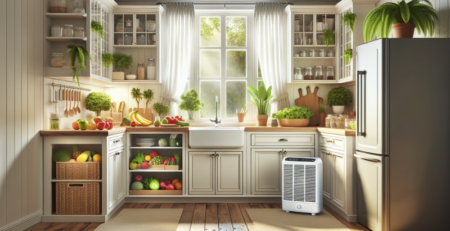Mold in Your Laundry Room: How to Keep It Dry
Mold in your laundry room is more than just an unsightly nuisance—it can pose serious health risks and cause long-term damage to your home. With the combination of moisture, heat, and poor ventilation, laundry rooms are a common breeding ground for mold and mildew. If left unchecked, mold growth can spread quickly, affecting walls, floors, and even your clothing. That’s why it’s essential to know how to keep your laundry room dry and mold-free. At Kraus Restoration, NJ’s leaders in water, mold, and fire damage restoration, we understand the urgency of tackling mold problems before they escalate. Our IICRC certified experts are available 24/7 to provide rapid response services throughout Central and Northern New Jersey. Whether you’re dealing with water damage, musty odors, or visible mold spots, call us at (973) 886-2021 for professional mold remediation and moisture control solutions. Keep reading to learn practical tips to prevent mold in your laundry room and maintain a healthier home environment.
Understanding Why Mold Thrives in Laundry Rooms
Mold is a common yet often underestimated problem in many households, particularly in laundry rooms. This space, while essential for maintaining cleanliness, ironically becomes a breeding ground for mold due to its unique environmental conditions. Understanding why mold thrives in laundry rooms is crucial for preventing its growth and maintaining a healthy indoor environment.
Laundry rooms are typically enclosed spaces with limited ventilation. They often house appliances such as washing machines and dryers, which generate significant amounts of moisture and heat. When this moisture is not properly ventilated or dried, it creates the perfect conditions for mold spores to settle and multiply. According to the Environmental Protection Agency (EPA), mold can begin to grow within 24 to 48 hours in moist conditions, making laundry rooms particularly vulnerable.
One of the primary reasons mold flourishes in laundry rooms is the presence of high humidity. Washing machines and dryers release steam and water vapor during operation. If the room lacks proper ventilation, this moisture accumulates in the air and on surfaces. Over time, this damp environment becomes ideal for mold growth. Additionally, leaks from plumbing fixtures or malfunctioning appliances can contribute to excess moisture, further exacerbating the problem.
Another contributing factor is the presence of organic materials. Mold feeds on cellulose-based substances such as lint, dust, and fabric fibers, all of which are commonly found in laundry rooms. Lint traps, for instance, can become clogged and retain moisture, creating a microenvironment where mold can thrive. Similarly, damp clothing left in the washer or laundry baskets provides an excellent food source for mold spores.
Poor maintenance and cleaning habits also play a significant role. Many homeowners overlook the importance of regularly cleaning behind and underneath appliances, where moisture and debris can accumulate unnoticed. These hidden areas often harbor mold colonies that can spread if not addressed promptly. Furthermore, dirty or clogged dryer vents can restrict airflow, causing humidity to build up inside the room.
The structural design of laundry rooms can also influence mold growth. Rooms located in basements or areas with poor insulation are more susceptible to condensation and dampness. Cold surfaces such as concrete walls or floors can attract moisture from the air, leading to condensation and mold formation. Inadequate sealing around windows, doors, and plumbing fixtures can allow water to seep in, especially during rainy seasons or high humidity periods.
To illustrate the common sources of mold in laundry rooms, consider the following examples:
- A leaking washing machine hose that drips water behind the appliance, creating a damp area that is rarely cleaned.
- A dryer vent that is not properly connected or cleaned, causing warm, moist air to circulate within the room.
- Damp clothes left in a laundry basket for extended periods, providing both moisture and organic material for mold to feed on.
- Poorly ventilated basement laundry rooms where humidity levels remain consistently high due to lack of airflow.
"Mold thrives in environments where there is moisture, warmth, and a food source. Laundry rooms often provide all three, making them a hotspot for mold growth if not properly maintained." — Centers for Disease Control and Prevention (CDC)
According to a study by the National Institute of Environmental Health Sciences, indoor mold exposure can lead to respiratory issues, allergic reactions, and other health problems, particularly in individuals with compromised immune systems. This underscores the importance of identifying and mitigating mold risks in laundry rooms.
To effectively combat mold, homeowners must first understand the conditions that promote its growth. Regular maintenance, proper ventilation, and moisture control are key strategies. Installing exhaust fans, using dehumidifiers, and ensuring that appliances are in good working order can significantly reduce the risk of mold. Additionally, routine inspections and professional mold remediation services can help detect and eliminate mold before it becomes a serious issue.
For those seeking professional assistance, Kraus Restoration offers comprehensive mold cleanup services tailored to residential and commercial properties. Their team of experts uses advanced techniques to identify mold sources, remove contamination, and restore affected areas to a safe and healthy condition.
Moreover, understanding the broader implications of mold in your home can help you take proactive steps. For example, if your laundry room is part of a larger basement area, it may be beneficial to explore Kraus Restoration’s water cleanup services to address any underlying moisture issues that could contribute to mold growth.
For more information on mold prevention and remediation, consider visiting reputable resources such as:
- EPA Mold Resources – Offers guidelines on mold prevention and cleanup.
- CDC Mold Information – Provides health-related information and mold safety tips.
- National Institute of Environmental Health Sciences – Discusses the health effects of mold exposure.
In conclusion, mold thrives in laundry rooms due to a combination of high humidity, poor ventilation, organic materials, and inadequate maintenance. By recognizing these contributing factors and implementing effective prevention strategies, homeowners can protect their living spaces from the harmful effects of mold. For those in need of expert help, Kraus Restoration offers a range of services designed to address mold, water, and fire damage, ensuring your home remains safe and dry. To learn more about their expertise and past work, visit their projects page or get in touch through their contact form.
Common Signs of Mold Growth You Shouldn’t Ignore
Mold growth in your laundry room can often go unnoticed until it becomes a significant problem. Recognizing the early signs of mold is essential to maintaining a healthy indoor environment and preventing costly damage. One of the most common indicators is a persistent musty odor. This smell is often the first sign that mold is present, even if it is not visible. It typically originates from damp areas behind appliances, under flooring, or within walls where moisture accumulates. If your laundry room consistently smells musty despite regular cleaning, it’s time to investigate further.
Another telltale sign is the appearance of visible mold. Mold can present itself in various colors, including black, green, white, or even orange, and it often appears as spots or patches on walls, ceilings, or around windows. In laundry rooms, mold frequently grows on drywall, behind washing machines, or near water connections where leaks or condensation occur. These patches may start small but can quickly spread if not addressed. Discoloration or staining on walls and ceilings, especially in areas that are prone to moisture, should not be ignored as they often indicate mold growth beneath the surface.
Excessive humidity and condensation are also red flags. If you notice water droplets forming on windows, pipes, or walls, it could be a sign that your laundry room lacks proper ventilation. High humidity levels create the perfect breeding ground for mold. Using a hygrometer to monitor humidity levels can help; ideally, indoor humidity should remain below 60 percent. If your laundry room consistently exceeds this threshold, it’s crucial to improve airflow and consider using a dehumidifier.
Peeling paint or wallpaper is another subtle yet significant sign of mold. Moisture trapped behind walls can cause paint to bubble or peel and wallpaper to lift. These changes in wall texture often accompany mold growth behind the surface, which may not be immediately visible. Similarly, warped or buckling flooring can indicate water damage and potential mold beneath the surface. Laundry rooms with vinyl or laminate flooring are particularly susceptible to this issue, especially if water has seeped into the subfloor.
Health symptoms experienced by household members can also point to hidden mold. Mold spores can trigger allergic reactions, respiratory issues, and other health problems, especially in individuals with asthma or weakened immune systems. If you or your family members experience frequent sneezing, coughing, itchy eyes, or skin irritation when spending time in or near the laundry room, mold could be the culprit. These symptoms often worsen in enclosed spaces with poor air circulation and high moisture levels.
Unexplained water leaks or dampness are also warning signs. Leaky washing machine hoses, clogged or slow-draining utility sinks, and faulty plumbing connections can all contribute to excess moisture. Even small leaks can lead to mold growth if left unaddressed. Regularly inspecting your appliances and plumbing for signs of wear and tear can help prevent these issues. If you discover any leaks, it’s important to repair them promptly and dry the affected area thoroughly to prevent mold from taking hold.
In some cases, mold may be hidden behind walls, under flooring, or inside vents, making it difficult to detect without professional help. If you suspect mold but cannot locate it, it may be time to consult a mold remediation expert. Professional inspections can identify hidden mold and assess the extent of the problem. At Kraus Restoration, our mold cleanup services are designed to safely and effectively remove mold from your home, including hard-to-reach areas.
It’s also important to consider the age and condition of your laundry room. Older homes or those with outdated plumbing and ventilation systems are more susceptible to mold issues. If your laundry room has not been updated in many years, it may lack the necessary features to manage moisture effectively. Renovating or upgrading your space with mold-resistant materials and improved ventilation can significantly reduce the risk of mold growth. You can explore some of our past residential design projects to see how modern solutions can enhance both functionality and safety in your home.
In addition to visual and olfactory clues, mold can also affect the performance of your appliances. Washing machines and dryers that are not functioning efficiently may be harboring mold within their components. Front-loading washers, in particular, are known for developing mold around the rubber door gasket. Regular maintenance, including cleaning the gasket and running cleaning cycles, can help prevent mold buildup. If you notice a decline in your appliance’s performance or detect a foul smell coming from the drum, it’s worth investigating further.
Finally, if you’ve experienced any form of water damage in your laundry room, whether from a flood, burst pipe, or appliance malfunction, the risk of mold increases significantly. Mold can begin to grow within 24 to 48 hours of water exposure, making prompt cleanup essential. Our water cleanup services are tailored to address such emergencies quickly and thoroughly, minimizing the chance of mold development.
Being proactive about identifying and addressing the signs of mold in your laundry room is crucial for maintaining a safe and healthy home. Ignoring these signs can lead to more extensive damage, higher repair costs, and potential health risks. If you’re unsure about the presence of mold or need assistance with remediation, don’t hesitate to contact our team at Kraus Restoration. We’re here to help you restore and protect your living space with expert solutions tailored to your needs.
The Health Risks Associated with Mold Exposure
Mold exposure, particularly in enclosed and often humid spaces like laundry rooms, can pose significant health risks to individuals of all ages. When mold spores are present in the air, they can be inhaled and lead to a variety of respiratory issues, especially for those with pre-existing conditions such as asthma, allergies, or compromised immune systems. Common symptoms of mold exposure include coughing, sneezing, nasal congestion, throat irritation, and skin rashes. In more severe cases, prolonged exposure can result in chronic respiratory problems, sinus infections, and even lung inflammation. Children, the elderly, and individuals with weakened immune systems are especially vulnerable to these health effects. Mold can also trigger asthma attacks and allergic reactions, making it a serious concern for households with sensitive individuals. The damp environment of a laundry room, especially if not properly ventilated or maintained, provides an ideal breeding ground for mold growth. This is why it is crucial to address any signs of moisture or mold promptly and thoroughly. Professional remediation services, such as those offered by Kraus Restoration, can help eliminate mold and prevent its recurrence. Their specialized mold cleanup solutions are designed to ensure a safe and healthy indoor environment. Additionally, understanding the broader scope of their services can help homeowners take proactive steps in maintaining their property. Whether dealing with a minor mold issue or a more extensive infestation, timely intervention is key to protecting your health and preserving the integrity of your home. For more information or to speak with a professional, you can easily contact Kraus Restoration for expert guidance and support.
How Humidity Contributes to Mold Problems
Humidity plays a critical role in the development and persistence of mold, especially in enclosed spaces like laundry rooms. Mold spores are naturally present in the air, but they require specific conditions to grow and spread. One of the most significant factors that contribute to mold growth is moisture, and humidity is a key source of that moisture. When the air in your laundry room becomes saturated with water vapor, it creates an ideal environment for mold to thrive. This is particularly problematic in laundry rooms due to the frequent use of water, steam from hot water cycles, and the presence of damp clothing and appliances like washing machines and dryers. If the humidity level remains consistently high, even for short periods, it can lead to condensation on walls, ceilings, and floors. These damp surfaces become breeding grounds for mold, especially in areas with poor ventilation.
High humidity not only encourages mold growth but also makes it more difficult to eliminate once it takes hold. Mold can grow on a variety of surfaces commonly found in laundry rooms, including drywall, wood, tile grout, and even on the rubber seals of washing machines. When humidity levels exceed 60 percent, the risk of mold increases significantly. This is why it is essential to monitor and control indoor humidity levels. Using a dehumidifier, ensuring proper ventilation, and promptly drying wet clothes and surfaces can help maintain a dry environment that discourages mold growth. Additionally, regular maintenance of appliances and plumbing can prevent leaks and water accumulation that contribute to elevated humidity.
Another factor to consider is the design and layout of your laundry room. Poorly designed spaces with limited airflow can trap moisture, making it difficult for the room to dry out properly. In such cases, even small amounts of humidity can lead to persistent mold issues. Incorporating exhaust fans, opening windows when weather permits, and using moisture-absorbing materials can significantly reduce the risk. If mold has already developed due to high humidity, professional intervention may be necessary. Services like mold cleanup are designed to safely and effectively remove mold and restore a healthy indoor environment.
Understanding how humidity contributes to mold problems is essential for preventing long-term damage and maintaining a safe, clean laundry room. Homeowners should also be aware that mold issues can extend beyond the laundry room if not addressed promptly. Mold spores can travel through the air and settle in other parts of the home, leading to widespread contamination. This is why it is crucial to take a proactive approach to moisture control. If you are unsure about the humidity levels in your home or need help identifying potential problem areas, consulting with professionals who specialize in restoration services can provide valuable insights and solutions.
In addition to practical measures, staying informed about the causes and consequences of mold growth can empower homeowners to take timely action. Resources such as the company’s about page offer more information on their expertise and commitment to helping clients maintain safe and healthy living spaces. By understanding the link between humidity and mold, and by implementing effective moisture control strategies, you can protect your laundry room and your entire home from the damaging effects of mold.
Proper Ventilation: Your First Line of Defense
One of the most effective ways to prevent mold growth in your laundry room is by ensuring proper ventilation. Laundry rooms are naturally prone to high humidity levels due to the frequent use of washers and dryers, both of which release moisture into the air. Without adequate airflow, this moisture can accumulate on walls, ceilings, and other surfaces, creating the perfect environment for mold to thrive. Installing a high-quality exhaust fan is a crucial step in maintaining a dry and mold-free space. Exhaust fans help to expel moist air outside, reducing the overall humidity and preventing condensation from forming on surfaces. Additionally, keeping windows open when weather permits or using a dehumidifier can further enhance air circulation and moisture control. It is also important to regularly inspect and clean dryer vents, as lint buildup can not only pose a fire hazard but also restrict airflow, contributing to excess moisture. If your laundry room is located in a basement or an area with limited natural ventilation, consider installing a mechanical ventilation system to ensure consistent air exchange. Proper ventilation not only protects your home from mold but also improves indoor air quality, making your laundry room a healthier and more comfortable space. For homeowners looking to upgrade their ventilation systems or address existing mold issues, professional help is often necessary. At Kraus Restoration, our team offers comprehensive services tailored to your specific needs, including expert mold cleanup solutions. Whether you are dealing with a current mold problem or want to prevent one from developing, our experienced professionals are here to help. Learn more about our approach and past work by exploring our residential design projects, where we showcase effective mold prevention strategies in action.
Choosing the Right Dehumidifier for Your Laundry Room
Selecting the appropriate dehumidifier for your laundry room is a crucial step in preventing mold growth and maintaining a healthy indoor environment. Laundry rooms are often exposed to high humidity levels due to the frequent use of washing machines and dryers, which release moisture into the air. Without proper ventilation and moisture control, this excess humidity can create the perfect breeding ground for mold and mildew. A dehumidifier helps by extracting moisture from the air, thereby reducing humidity levels and making it harder for mold to thrive. However, not all dehumidifiers are created equal, and choosing the right one involves considering several important factors.
First and foremost, you need to assess the size of your laundry room. Dehumidifiers come in various capacities, typically measured in pints of moisture removed per day. For smaller laundry rooms, a compact unit with a capacity of 20 to 30 pints may suffice. Larger spaces or rooms with consistently high humidity might require a more powerful model capable of removing 50 to 70 pints per day. It is essential to match the dehumidifier’s capacity to the room size to ensure efficient moisture control. Overestimating the capacity can lead to unnecessary energy consumption, while underestimating it may result in inadequate dehumidification.
Another critical factor to consider is the humidity level in your laundry room. If you live in a region with high ambient humidity or if your laundry room lacks proper ventilation, you may need a more robust dehumidifier. Many modern units come with built-in hygrometers that allow you to monitor and set your desired humidity level, typically between 30 and 50 percent for optimal mold prevention. Look for a model with an automatic humidistat, which adjusts the operation based on the current humidity level, ensuring consistent performance without constant manual adjustments.
Energy efficiency is also an important consideration, especially if you plan to run the dehumidifier frequently. Look for units with the Energy Star certification, which indicates that the appliance meets energy efficiency guidelines set by the Environmental Protection Agency. Energy-efficient models not only reduce your electricity bills but also have a smaller environmental footprint. Additionally, features such as programmable timers, auto shut-off, and sleep modes can further enhance energy savings and convenience.
Ease of maintenance is another aspect that should not be overlooked. Dehumidifiers require regular upkeep to function effectively. Choose a model with a washable air filter, which helps trap dust and allergens, and a removable water tank that is easy to empty and clean. Some units also offer continuous drainage options, allowing you to connect a hose and direct the collected water to a nearby drain, eliminating the need to manually empty the tank. This feature is particularly useful in laundry rooms where the dehumidifier may be running for extended periods.
Noise level is a practical consideration, especially if your laundry room is located near living spaces or bedrooms. While all dehumidifiers produce some level of noise, some models are designed to operate more quietly than others. Check the decibel rating of the unit before purchasing, and opt for one that balances performance with quiet operation. Many manufacturers provide noise level specifications, which can help you make an informed decision based on your household’s needs.
Portability and design may also influence your choice. If you anticipate moving the dehumidifier between rooms or storing it when not in use, look for a lightweight model with caster wheels and a compact design. Some units are specifically designed for tight spaces and can be placed on countertops or mounted on walls, making them ideal for smaller laundry rooms. Aesthetic considerations, such as color and finish, might also be important if you want the appliance to blend seamlessly with your existing decor.
Advanced features can further enhance the functionality and user experience of your dehumidifier. For instance, some models come with smart technology that allows you to control and monitor the unit remotely via a smartphone app. This can be particularly useful for busy households, as it enables you to adjust settings and receive maintenance alerts even when you are not at home. Other useful features include auto-restart, which resumes operation after a power outage, and frost control, which prevents the coils from freezing in cooler environments.
When choosing a dehumidifier, it is also wise to consider the brand’s reputation and customer support. Opt for a manufacturer known for producing reliable and durable appliances. Reading customer reviews and checking warranty information can provide valuable insights into the product’s performance and longevity. A good warranty and responsive customer service can offer peace of mind and ensure that you receive assistance if any issues arise.
In addition to selecting the right dehumidifier, it is important to integrate it into a broader strategy for moisture control in your laundry room. This includes ensuring proper ventilation, using exhaust fans, and sealing any leaks or cracks that may allow moisture to enter. Regular maintenance of your washing machine and dryer, such as cleaning lint traps and checking hoses, can also help reduce humidity levels. For more comprehensive solutions, consider consulting professionals who specialize in mold cleanup and moisture management.
If you are unsure about the best dehumidifier for your specific needs, reaching out to experts can be a valuable step. At Kraus Restoration, we offer a range of services designed to help homeowners maintain safe and healthy living environments. Our team can assess your laundry room, recommend suitable equipment, and provide guidance on effective mold prevention strategies. Whether you are dealing with existing mold issues or looking to prevent future problems, our experience and dedication to quality service can make a significant difference.
For those interested in learning more about our approach and past work, we invite you to explore our projects page, where you can find examples of residential and commercial solutions tailored to various needs. From initial consultation to final implementation, we are committed to delivering results that exceed expectations. If you have any questions or would like to schedule a consultation, please do not hesitate to contact us. Our team is here to help you create a cleaner, drier, and healthier laundry room environment.
Tips for Keeping Your Washing Machine Mold-Free
One of the most common yet overlooked sources of mold in the laundry room is the washing machine itself. Due to its frequent exposure to moisture, detergent residues, and fabric softeners, the interior of a washing machine can become a breeding ground for mold and mildew if not properly maintained. To keep your washing machine mold-free, it is essential to adopt a few simple but effective habits. First, always leave the washer door or lid open after each use to allow air circulation and prevent moisture from being trapped inside. This is especially important for front-loading machines, which are more prone to mold buildup around the rubber gasket. Regularly wiping down the door seal, detergent drawer, and drum with a clean, dry cloth can also help eliminate residual moisture and soap scum that contribute to mold growth. Additionally, running a monthly cleaning cycle using either a commercial washing machine cleaner or a homemade solution of white vinegar and baking soda can effectively disinfect the interior and remove any lingering odors. Avoid using excessive detergent, as this can leave behind a film that encourages mold. Instead, use the recommended amount and opt for high-efficiency (HE) detergents if your machine requires them. It is also wise to inspect and clean the filter and drain pump periodically, as trapped debris can lead to standing water and mold. For households in humid climates or with limited ventilation, using a dehumidifier in the laundry room can further reduce moisture levels and inhibit mold development. If you suspect that mold has already taken hold in your washing machine or surrounding areas, professional assistance may be necessary. At Kraus Restoration, we offer comprehensive mold cleanup solutions tailored to your specific needs. Our experienced team is equipped to handle mold issues at their source, ensuring a cleaner and healthier environment. To learn more about our range of services or to schedule an inspection, feel free to reach out through our contact page. Taking proactive steps to maintain your washing machine not only extends its lifespan but also plays a crucial role in keeping your laundry room dry and mold-free.
The Importance of Regular Cleaning and Maintenance
Maintaining a clean and dry laundry room is essential in preventing mold growth, which can lead to serious health issues and structural damage if left unchecked. Regular cleaning and maintenance not only help in identifying early signs of mold but also ensure that moisture does not accumulate in hidden corners or behind appliances. Mold thrives in damp, dark environments, and laundry rooms are particularly vulnerable due to the frequent use of water and the presence of humidity. By incorporating a consistent cleaning routine, homeowners can significantly reduce the risk of mold infestation. This includes wiping down surfaces, checking for leaks, and ensuring that washing machines and dryers are functioning properly and vented correctly. Additionally, inspecting hoses and connections for any signs of wear or leakage can prevent water from seeping into walls or flooring. Using dehumidifiers or improving ventilation can also help maintain optimal humidity levels. For those who suspect mold or have experienced water damage, seeking professional help is crucial. Companies like Kraus Restoration offer specialized mold cleanup and water cleanup services to address these issues effectively. Regular maintenance also extends the lifespan of your appliances and keeps your laundry room functioning efficiently. It is also beneficial to stay informed about best practices and new methods for mold prevention. For more information about the company’s approach and expertise, you can explore their about page or view their completed residential design projects to see how they have helped other homeowners maintain safe and clean environments. Ultimately, a proactive approach to cleaning and maintenance is the most effective way to keep your laundry room dry, safe, and mold-free.
How to Spot and Fix Leaks Before Mold Develops
Preventing mold in your laundry room starts with identifying and addressing leaks before they become a serious problem. Moisture is the primary catalyst for mold growth, and even small, unnoticed leaks can create the perfect environment for mold to thrive. Begin by conducting a thorough inspection of your laundry room, focusing on areas around the washing machine, utility sink, and any exposed plumbing. Check for signs of water damage such as discoloration on walls or ceilings, warped flooring, or a musty odor, which often indicates hidden moisture. Pay special attention to the hoses connected to your washing machine. Over time, these hoses can wear out or become loose, leading to slow leaks that may go unnoticed until mold has already begun to form. Replacing old or brittle hoses with newer, more durable ones can prevent future issues.
Another common source of leaks is the washing machine itself. Front-loading machines, in particular, are known for developing leaks around the door seal. Regularly inspect the rubber gasket for signs of wear, mold, or trapped debris, and clean it with a mild detergent to maintain a tight seal. Additionally, ensure that your washing machine is level. An unbalanced machine can cause excessive vibration, which may loosen connections and lead to leaks over time. If you notice water pooling under or around the machine, investigate immediately rather than assuming it’s just a minor spill.
The utility sink, often found in laundry rooms, is another potential source of leaks. Check the faucet and the pipes underneath for any drips or corrosion. Even a slow drip can lead to significant moisture buildup over time. Tighten any loose fittings and replace worn-out washers or seals. If you notice persistent leaks or signs of water damage around the sink area, it may be time to consult a professional plumber to assess the situation more thoroughly.
Walls and ceilings should also be examined for any signs of water intrusion. This is particularly important if your laundry room is located in a basement or on the ground floor, where water from outside can seep in through cracks or poorly sealed windows. Look for bubbling paint, peeling wallpaper, or soft spots in drywall, all of which can indicate hidden moisture. Sealing any gaps or cracks with waterproof caulking and ensuring proper insulation can help prevent water from entering your laundry space.
Ventilation plays a crucial role in keeping your laundry room dry. Without adequate airflow, even minor leaks can create a humid environment that encourages mold growth. Make sure your dryer is properly vented to the outside and that the vent hose is free of lint and debris. A clogged vent not only reduces efficiency but also increases humidity levels in the room. Installing a dehumidifier can also help maintain optimal moisture levels, especially in areas prone to dampness.
Regular maintenance is key to preventing leaks and subsequent mold issues. Create a checklist for monthly inspections that includes examining hoses, checking under sinks, inspecting walls and ceilings, and testing the functionality of your ventilation system. Early detection of leaks allows for prompt repairs, which can save you from costly mold remediation down the line. If you do discover mold or water damage, it’s essential to act quickly. Professional services like water cleanup and mold cleanup can ensure that the problem is thoroughly addressed and that your laundry room is restored to a safe, dry condition.
In some cases, leaks may originate from sources outside the laundry room, such as a leaking roof or plumbing issues in adjacent rooms. If you suspect that the moisture is coming from an external source, it’s important to conduct a broader inspection of your home. This may involve checking the attic, roof, and other plumbing systems. For comprehensive solutions, consider reaching out to professionals who specialize in home restoration. You can learn more about the range of services offered by visiting the services page.
Additionally, reviewing past residential design projects can provide insight into how others have successfully managed moisture control in similar spaces. These examples can offer practical ideas for improving your own laundry room’s resistance to leaks and mold. Whether it’s upgrading materials, improving drainage, or enhancing ventilation, proactive measures can make a significant difference.
Ultimately, the key to preventing mold in your laundry room lies in vigilance and timely action. By regularly inspecting for leaks, maintaining your appliances, and ensuring proper ventilation, you can create a dry, mold-resistant environment. Don’t wait for visible signs of mold to appear before taking action. Early intervention not only protects your home but also safeguards your health and well-being. If you need expert advice or assistance, don’t hesitate to contact a professional restoration service to help keep your laundry room dry and mold-free.
Best Flooring Options to Prevent Moisture Buildup
When it comes to preventing mold in your laundry room, one of the most critical factors to consider is the type of flooring you choose. Moisture buildup is a common issue in laundry areas due to the presence of water sources, humidity, and the potential for leaks or spills. Selecting the right flooring can make a significant difference in maintaining a dry environment and reducing the risk of mold growth. The best flooring options for moisture-prone areas like laundry rooms are those that are water-resistant, easy to clean, and durable under frequent use.
Tile flooring, particularly ceramic or porcelain tile, is one of the most effective choices for laundry rooms. These materials are non-porous, which means they do not absorb water easily, making them highly resistant to moisture damage. Additionally, tile is easy to clean and maintain, which helps prevent mold spores from settling into the surface. For added protection, it is essential to ensure that the grout lines are sealed properly, as unsealed grout can absorb moisture and become a breeding ground for mold.
Another excellent option is luxury vinyl flooring. This type of flooring has gained popularity due to its water-resistant properties and realistic appearance that can mimic wood or stone. Luxury vinyl planks or tiles are made with a waterproof core, making them ideal for areas with high humidity levels. They are also softer underfoot compared to tile, which can be a bonus in a space where you may be standing for extended periods while doing laundry. Moreover, luxury vinyl is relatively easy to install and replace if any damage occurs.
Concrete flooring is another viable solution, especially in modern or industrial-style homes. When sealed properly, concrete is highly resistant to moisture and can be customized with stains or finishes to enhance its appearance. It is also incredibly durable and can withstand heavy appliances and foot traffic. However, it is important to note that concrete can feel cold and hard, so adding area rugs or mats in key areas can improve comfort without compromising moisture resistance.
Engineered wood flooring is sometimes considered for laundry rooms due to its aesthetic appeal, but it must be chosen carefully. Unlike solid hardwood, engineered wood has a plywood base that provides better stability and resistance to moisture. However, it is still not as water-resistant as tile or vinyl, so it should only be used if the laundry room has excellent ventilation and minimal risk of water exposure. If you opt for engineered wood, make sure it is specifically rated for moisture-prone areas and that all seams are sealed to prevent water infiltration.
Rubber flooring is another practical choice, especially for utility spaces. It is naturally water-resistant, slip-resistant, and provides a cushioned surface that is comfortable to walk on. Rubber tiles or rolls are easy to install and can be removed or replaced if needed. This type of flooring is also resistant to mold and mildew, making it a smart option for keeping your laundry room dry and safe.
Cork flooring offers a unique combination of comfort and moisture resistance. While cork is naturally resistant to mold and mildew, it must be sealed properly to prevent water damage. When sealed, cork can be a warm and eco-friendly flooring choice that adds a touch of softness to your laundry room. However, it may not be suitable for areas with frequent water spills unless maintained meticulously.
In addition to choosing the right flooring material, proper installation and maintenance are crucial. Ensure that the subfloor is dry and level before installation to prevent future moisture issues. Using a moisture barrier or underlayment can provide an extra layer of protection, especially in basements or ground-level laundry rooms. Regular cleaning and prompt attention to spills or leaks will also help maintain the integrity of your flooring and prevent mold growth.
If you are planning a renovation or new construction, working with professionals who understand the importance of moisture control in laundry rooms is essential. At Kraus Restoration, we offer a range of services designed to help homeowners create safe and functional living spaces. Our team can guide you through the selection and installation of the best flooring options to suit your needs and budget.
For those interested in seeing how different flooring materials perform in real-life settings, our residential design projects showcase a variety of solutions tailored to moisture-prone areas. Whether you are updating an existing laundry room or building a new one, choosing the right flooring is a key step in preventing mold and maintaining a healthy home environment.
Ultimately, the best flooring for preventing moisture buildup in your laundry room will depend on your specific needs, preferences, and the conditions of your space. By prioritizing water resistance, durability, and ease of maintenance, you can significantly reduce the risk of mold and enjoy a cleaner, safer laundry area for years to come.
Using Mold-Resistant Paint and Materials
One of the most effective ways to prevent mold growth in your laundry room is by using mold-resistant paint and building materials. These specially formulated products are designed to withstand high humidity and moisture, which are common in laundry areas. Mold-resistant paint contains antimicrobial agents that inhibit the growth of mold and mildew on painted surfaces. Applying this type of paint to walls, ceilings, and even cabinetry can create a protective barrier that significantly reduces the risk of mold development. Additionally, using mold-resistant drywall, also known as green board or purple board, can further enhance your laundry room’s defense against moisture. These materials are engineered with water-repellent cores and mold-inhibiting properties, making them ideal for damp environments. When renovating or building a laundry room, it is wise to choose flooring options like ceramic tile or vinyl, which are less likely to absorb water compared to carpet or wood. Sealing all joints and edges with waterproof caulk can also help prevent water from seeping into hidden areas where mold can thrive. For homeowners considering a full remodel or new construction, consulting with professionals who specialize in moisture control and mold prevention is highly recommended. You can explore the range of services offered by experienced restoration companies to ensure your laundry room is built with the right materials from the start. Additionally, reviewing past residential design projects can provide inspiration and confidence in selecting the best mold-resistant solutions for your space. Taking these proactive steps not only protects your home but also contributes to a healthier indoor environment for your family.
Natural Remedies to Prevent Mold Growth
One of the most effective ways to maintain a dry and mold-free laundry room is by incorporating natural remedies that help prevent mold growth without relying on harsh chemicals. Mold thrives in damp, poorly ventilated environments, making laundry rooms a common hotspot. Fortunately, several natural solutions can help you combat this issue while promoting a healthier indoor environment. Vinegar is one of the most widely used natural mold deterrents. Its acidic nature helps kill mold spores and prevent them from returning. Simply mix equal parts white vinegar and water in a spray bottle and apply it to areas prone to moisture, such as behind the washing machine, around the utility sink, and along baseboards. Let it sit for an hour before wiping it clean. For added effectiveness, use undiluted vinegar on stubborn spots. Another powerful natural remedy is baking soda. Not only does it absorb moisture, but it also neutralizes odors and inhibits mold growth. Sprinkle baking soda in damp corners or mix it with water to form a paste that can be applied to mold-prone surfaces. After letting it sit for a few minutes, scrub the area and rinse thoroughly. Tea tree oil is another excellent natural antifungal agent. Though more expensive than vinegar or baking soda, it is highly effective in small quantities. Mix one teaspoon of tea tree oil with one cup of water in a spray bottle and apply it to affected areas. Do not rinse; allow it to air dry for long-lasting protection. In addition to these remedies, maintaining proper airflow is crucial. Use a dehumidifier or keep windows open when possible to reduce humidity levels. Placing moisture-absorbing materials like charcoal briquettes or silica gel packets in corners and cabinets can also help. Regularly cleaning your washing machine, especially the rubber gasket and detergent drawer, is essential to prevent mold buildup. For more comprehensive solutions and professional assistance, consider exploring our mold cleanup services. If you are interested in learning more about our team and approach, visit our about page. By integrating these natural remedies into your routine and staying vigilant, you can significantly reduce the risk of mold in your laundry room and maintain a cleaner, healthier home environment.
When to Call a Professional Mold Remediation Service
If you’ve discovered mold in your laundry room, it’s essential to assess the severity of the issue before deciding whether to handle it yourself or call in a professional mold remediation service. While minor mold problems can often be addressed with household cleaning solutions and improved ventilation, there are specific situations where professional intervention becomes necessary. One of the most critical indicators that you need expert help is the size of the affected area. According to the Environmental Protection Agency (EPA), if the moldy area is larger than 10 square feet, professional remediation is strongly recommended. This is because extensive mold growth often indicates a deeper, underlying moisture problem that may not be visible on the surface. In such cases, simply cleaning the visible mold will not resolve the issue, and the mold is likely to return unless the root cause is addressed.
Another sign that it’s time to call a professional is if you notice persistent musty odors even after cleaning. Mold can grow behind walls, under flooring, or inside HVAC systems, making it difficult to locate and eliminate without specialized equipment. Professionals use advanced tools such as moisture meters, infrared cameras, and air quality monitors to detect hidden mold and moisture sources. If your laundry room has experienced water damage from a burst pipe, flooding, or a leaking appliance, it’s wise to consult a mold remediation expert. Water damage often leads to mold growth within 24 to 48 hours, and the longer it goes untreated, the more extensive the contamination can become. In these cases, a professional service can provide comprehensive water cleanup and mold removal to ensure your home is safe and dry.
Health concerns are another compelling reason to seek professional help. Mold exposure can cause a range of health issues, particularly for individuals with allergies, asthma, or weakened immune systems. Symptoms may include coughing, sneezing, skin irritation, and respiratory problems. If you or your family members are experiencing unexplained health symptoms that seem to worsen when spending time in or near the laundry room, it’s crucial to have the area inspected by a certified mold remediation specialist. These professionals are trained to handle mold safely, using protective gear and containment procedures to prevent spores from spreading to other parts of your home.
Additionally, if you’ve attempted to clean the mold yourself but it keeps coming back, this is a clear sign that the underlying moisture problem has not been resolved. Mold thrives in damp, humid environments, and without proper remediation, it will continue to grow and spread. A professional service will not only remove the existing mold but also identify and fix the source of moisture, whether it’s poor ventilation, a plumbing leak, or condensation issues. They may also recommend improvements such as installing a dehumidifier or upgrading your ventilation system to prevent future mold growth.
Choosing a reputable mold remediation company is essential for effective and lasting results. Look for a company with certified technicians, positive customer reviews, and a proven track record of successful projects. At Kraus Restoration, we offer a full range of services designed to restore your home to a safe and healthy condition. Our team is experienced in handling all types of mold issues, from minor infestations to large-scale contamination. We follow industry best practices and use environmentally friendly products to ensure your home is not only mold-free but also safe for your family and pets.
In some cases, mold damage may be extensive enough to require structural repairs or renovations. For example, if mold has compromised drywall, flooring, or cabinetry in your laundry room, these materials may need to be removed and replaced. A professional remediation service can coordinate these repairs and ensure that all affected areas are properly restored. You can view some of our past residential design projects to see how we’ve helped homeowners recover from mold and water damage with high-quality restoration work.
Finally, if you’re unsure about the extent of the mold problem or how to proceed, it’s always better to err on the side of caution and consult a professional. Many companies, including ours, offer initial inspections and consultations to help you understand the scope of the issue and the best course of action. Don’t wait until the problem worsens or causes significant damage to your home and health. Reach out to a trusted mold remediation expert to ensure your laundry room remains a clean, dry, and safe space for your household. If you have questions or need immediate assistance, feel free to contact us today.
Creating a Mold Prevention Checklist for Your Laundry Room
To effectively combat mold in your laundry room and maintain a consistently dry environment, it is essential to develop a comprehensive mold prevention checklist. This checklist should begin with regular inspections of the laundry area, focusing on commonly overlooked spots such as behind the washer and dryer, under laundry baskets, and around baseboards. Moisture-prone areas should be monitored weekly to catch early signs of mold growth. Ensuring proper ventilation is another critical step; always use an exhaust fan or open a window during and after laundry cycles to reduce humidity. If your laundry room lacks natural airflow, consider installing a dehumidifier to maintain optimal moisture levels. Additionally, inspect and maintain all appliances regularly. Check hoses and connections for leaks or cracks, and replace them as needed to prevent water accumulation. Clean the lint trap after every dryer use and periodically inspect the dryer vent for blockages that could lead to excess moisture buildup. Another important task is to avoid leaving wet clothes in the washer for extended periods, as this creates an ideal environment for mold to thrive. Instead, transfer clothes to the dryer or hang them to dry immediately after the wash cycle ends. Keep the washer door open when not in use to allow the interior to dry completely. Organizing your laundry room can also play a role in mold prevention. Store detergents and cleaning supplies in sealed containers and off the floor to avoid moisture contact. Use shelving units to keep items elevated and ensure that nothing is blocking airflow around the room. Regularly clean all surfaces, including floors, walls, and appliances, using mold-inhibiting cleaners. For homes that have experienced previous water damage or mold issues, it may be beneficial to consult with professionals who specialize in mold cleanup to assess and treat any lingering problems. Additionally, understanding the broader range of services available for water and mold damage can help you stay prepared for future issues. If you are planning a renovation or redesign of your laundry space, consider incorporating moisture-resistant materials and consulting experts in residential design to create a layout that promotes airflow and minimizes dampness. By following a detailed mold prevention checklist and staying proactive with maintenance and cleaning, you can significantly reduce the risk of mold growth and ensure your laundry room remains a clean, dry, and healthy space.
Sure! Here’s a suitable FAQ section for a blog post titled "Mold in Your Laundry Room: How to Keep It Dry," based on general knowledge and best practices for preventing mold:
Frequently Asked Questions (FAQ)
-
Why is mold common in laundry rooms?
Laundry rooms are prone to mold because they often have high humidity, poor ventilation, and frequent exposure to moisture from washing machines, wet clothes, and plumbing. These damp conditions create the perfect environment for mold growth. -
What are the signs of mold in a laundry room?
Common signs include a musty odor, visible black or green spots on walls, ceilings, or around appliances, and increased allergy symptoms like sneezing or coughing when in the room. -
How can I prevent mold in my laundry room?
To prevent mold, keep the room well-ventilated by using exhaust fans or opening windows. Regularly check for leaks, clean lint traps, and avoid leaving wet clothes in the washer. Use a dehumidifier if humidity levels are high. -
What humidity level should I maintain to prevent mold?
Aim to keep indoor humidity below 60%, ideally between 30% and 50%. You can use a hygrometer to monitor humidity levels in your laundry room. -
Can mold in the laundry room affect my health?
Yes, mold can trigger allergic reactions, asthma attacks, and respiratory issues, especially in people with sensitivities. It’s important to address mold promptly to maintain a healthy indoor environment. -
How do I clean mold if I find it?
Small areas of mold can be cleaned with a mixture of water and detergent or white vinegar. Wear gloves and a mask while cleaning. For larger infestations or if mold keeps returning, consider hiring a professional. -
Should I leave the washer door open after use?
Yes, leaving the washer door open allows the interior to dry out, reducing the chance of mold and mildew developing inside the machine. -
Is it safe to use bleach to clean mold?
Bleach can be effective on non-porous surfaces, but it may not penetrate porous materials like drywall. Use with caution and ensure proper ventilation. For porous surfaces, consider using vinegar or a commercial mold cleaner. -
How often should I inspect my laundry room for mold?
It’s a good idea to inspect your laundry room monthly for signs of moisture, leaks, or mold. Regular maintenance can help catch issues early before they become serious problems. -
What should I do if mold keeps coming back?
Persistent mold may indicate a hidden moisture problem, such as a leak behind walls or poor ventilation. Consult a mold remediation specialist to assess and resolve the underlying issue.
This FAQ section can be added to the end of your blog post to provide readers with quick, helpful answers to common concerns about mold in laundry rooms.
